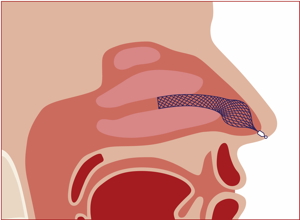|
YOUR NOSE IS TOO NARROW?
Get more air without surgery!
YOUR NOSE IS SWOLLEN?
Restore nasal breathing!
YOU SNORE?
Well rested due to better sleep quality!
AND DURING SPORTS?
Endurance by nasal instead of mouth breathing!
Alaxo nasal stents are innovative medical devices that
support and optimize healthy, natural nasal breathing.
They increase well-being and performance by restoring and
improving the body's natural functions.
Product variants:

Top: AlaxoLito Nasal Nasal Stent, bottom AlaxoLito Plus
Nasal Stent (each stent and introduction tube)
1) AlaxoLito Nasal Stent (35 mm)
for application in the anterior
nasal cavity

2) AlaxoLito Plus Nasal Stent (60 mm)
for optimization of the entire
nasal passage
3) AlaxoLito Xtreme Nasal Stent (60 mm)
with higher radial force
in particular for use during
sports

The nasal stents are inserted by the user himself for
repeated use (up to 18 hours per application). After a
period of adaptation, the application becomes an everyday
routine (comparable to contact lenses).
The alternative to surgery!
Today, ENT surgery is usually recommended as a therapy,
for example, a reduction in the size of the turbinates or
surgical straightening of the nasal septum. However, these
operations often do not bring lasting success.
AlaxoLito nasal stents:
- innovative
- gentle
- purely mechanical
- no surgery
- free of drugs
As a result, the body function is improved. Everything
"runs more smoothly".
Application of the nasal stents is demonstrated in
the following video
|
|
MAXIMUM POWER
Relaxed and with less effort!
PERFORMANCE
Long-lasting instead of temporarily stimulated!
RECOVERY
After exercise quicker fit again!
MUSCLE SOARNESS
Less or no more!
ENERGY AND POWER
Increased also in everyday life!
Elite athletes are systematically trained to breathe
through their nose for as long as possible. With the
AlaxoLito Xtreme Nasal Stent sports with nasal breathing
lasting for hours becomes possible even at high physical
load:
- increases the inhaled air volume up to more than double
- supports the endogenous functions of the body
- increases power and endurance
- enables better and healthier sports in the aerobic range
- prevents too strong burden to the lung by mouth
breathing, e.g. in case of asthma
- natural mode of action
- purely mechanical effect
- no drugs
- no stimulants
- no doping
Nasal breathing
- natural healthy way of breathing
- transports nitric oxide (NO) from the nose to the lung,
organs and muscles
- NO is highly important for muscle functionality
- effects power & endurance
- but airflow rate subjectively not sufficient at high
physical load
Mouth breathing
- designed only for short periods of high peak power
- lower NO transport to lung
- nevertheless mostly used during sports
- mouth breathing over a longer period leads to oxidative
stress
- this reduces performance
Clinically tested
A clinical study at the German Sport University Cologne
(1) has shown that by nasal breathing with stents
- breathing is slower and deeper
- perfuison (microcirculation) is improved
- supply of oxygen, NO and nutrients to the muscles is
more efficient
- parasympathetic nervous system (for well-being) is
activated
- the body is better prepared for exercise and physical
load
- and recovers more quickly from load
The good NO supply increases activity and performance of
mitochondria (power plants of the cells).
(1) Bizjak et al; The intranasal AlaxoLito Plus Nasal
Stent: Improvement of NO-induced microrheology and
oxygen uptake during exercise?; Respiratory Physiology
& Neurobiology 269, 103260 (2019).
doi.org/10.1016/j.resp.2019.103260
How to get used?
The use of AlaxoLito Nasal Stents requires an adaptation
phase similar to that of contact lenses. Initially,
increased mucus formation in the nose and a foreign body
sensation are normal. Depending on the individual nasal
anatomy, this phase lasts from one to several weeks. There
is a short-term effect of improved nasal breathing within
the first few weeks. Full optimization of nasal breathing,
however, is a process over many months, similar to dental
braces. A permanent widening of the nasal passage develops
during this process.
|
|



